A microscope image of a dark Bennu particle, about a millimeter long, with a crust of bright phosphate. To the right is a smaller fragment that broke off. Credit: From Lauretta & Connolly et al. (2024) Meteoritics & Planetary Science, doi:10.1111/maps.14227
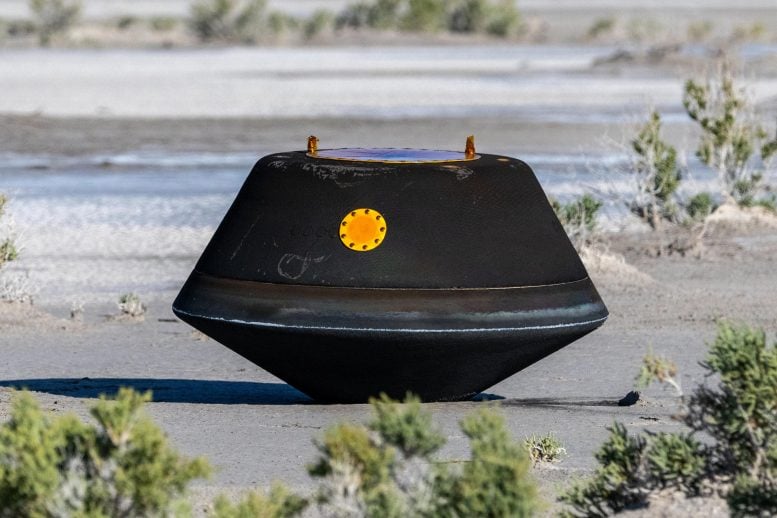
The sample return capsule from NASA’s OSIRIS-REx mission is seen shortly after touching down in the desert on September 24, 2023, at the Department of Defense’s Utah Test and Training Range. The sample was collected from the asteroid Bennu in October 2020 by NASA’s OSIRIS-REx spacecraft. Credit: NASA/Keegan Barber
Journey and Delivery of the Bennu Sample
Launched on September 8, 2016, the Origins, Spectral Interpretation, Resource Identification, and Security–Regolith Explorer spacecraft, dubbed OSIRIS-REx, began its journey to near-Earth asteroid Bennu to collect a sample of rocks and dust from the surface. OSIRIS-REx was the first U.S. mission to collect a sample from an asteroid. The spacecraft delivered the sample, weighing 4.3 ounces, or 121.6 grams, to Earth on September 24, 2023.
“Finally having the opportunity to delve into the OSIRIS-REx sample from Bennu after all these years is incredibly exciting,” said Dante Lauretta, principal investigator for OSIRIS-REx and Regents Professor of planetary sciences in the University of Arizona Lunar and Planetary Laboratory. “This breakthrough not only answers longstanding questions about the early solar system but also opens new avenues of inquiry into the formation of Earth as a habitable planet. The insights outlined in our overview paper have sparked further curiosity, driving our eagerness to explore deeper.”
Lauretta is co-lead author of a paper published in Meteoritics & Planetary Science that details the nature of the asteroid sample. The paper also serves as an introduction to the Bennu sample catalog, an online resource where information about the sample is made publicly available and where scientists can request sample material for their own research.
“The publication of the first paper led by Dr. Lauretta and Dr. Connolly describing the Bennu sample is an exciting milepost for the mission and for the Lunar and Planetary Laboratory,” said Mark Marley, director of the UArizona Lunar and Planetary Laboratory and head of the Department of Planetary Sciences. “Our faculty, scientists and students will continue to study the sample for years and decades to come. For now, we can only imagine the stories of the origins of our planet and the life upon it still to be told by the Bennu grains already in our laboratories.”
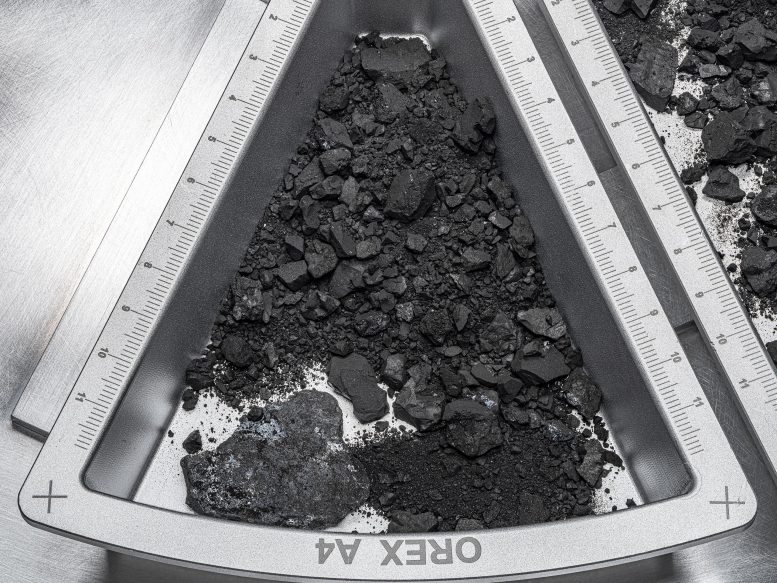
A top-down view of one of the containers holding rocks and dust from asteroid Bennu, with hardware scale marked in centimeters. Credit: NASA/Erika Blumenfeld and Joseph Aebersold
A ‘Watery Past’ for Bennu?
Analysis of the Bennu sample unveiled intriguing insights into the asteroid’s composition. Dominated by clay minerals, particularly serpentine, the sample mirrors the type of rock found at mid-ocean ridges on Earth, where material from the mantle, the layer beneath Earth’s crust, encounters water.
This interaction between ocean water and materials from the Earth’s mantle results in clay formation and gives rise to a variety of minerals including carbonates, iron oxides and iron sulfides. But the most unexpected discovery in the Bennu sample is the presence of water-soluble phosphates, Lauretta said. These compounds are components of biochemistry for all known life on Earth today.
A similar phosphate was found in the asteroid Ryugu sample delivered by the Japan Aerospace Exploration Agency’s Hayabusa2 mission in 2020. But the magnesium sodium phosphate detected in the Bennu sample stands out for the lack of inclusions, which are like little bubbles of other minerals trapped within the rock, and the size of its grains, unprecedented in any meteorite sample, Lauretta said.
The finding of magnesium sodium phosphates in the Bennu sample raises questions about the geochemical processes that brought these elements together, and provides valuable clues about Bennu’s historic conditions.
“The presence and state of phosphates, along with other elements and compounds on Bennu, suggest a watery past for the asteroid,” Lauretta said. “Bennu potentially could have once been part of a wetter world. Although, this hypothesis requires further investigation.”
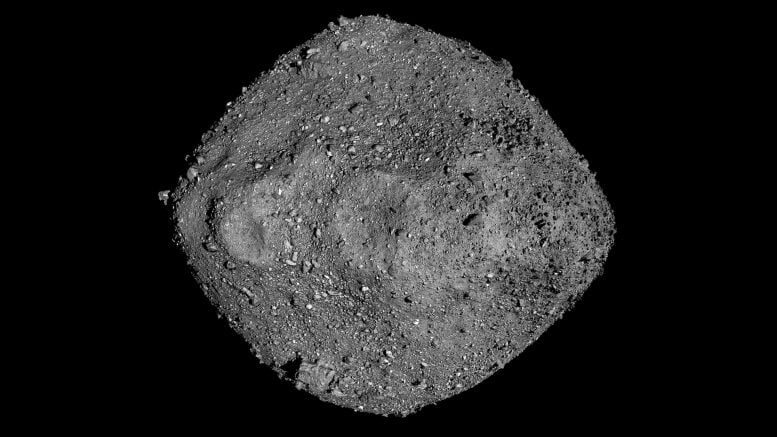
This mosaic of Bennu was created using observations made by NASA’s OSIRIS-REx spacecraft that was in close proximity to the asteroid for over two years. Credit: NASA/Goddard/University of Arizona
From a Young Solar System
Despite its possible history of interaction with water, Bennu remains a chemically primitive asteroid, with elemental proportions closely resembling those of the sun.
“The sample we returned is the largest reservoir of unaltered asteroid material on Earth right now,” Lauretta said.
The asteroid’s composition offers a glimpse into the early days of our solar system, over 4.5 billion years ago. The rocks have retained their original state, having neither melted nor resolidified since their creation, affirming their pristine nature and ancient origins.
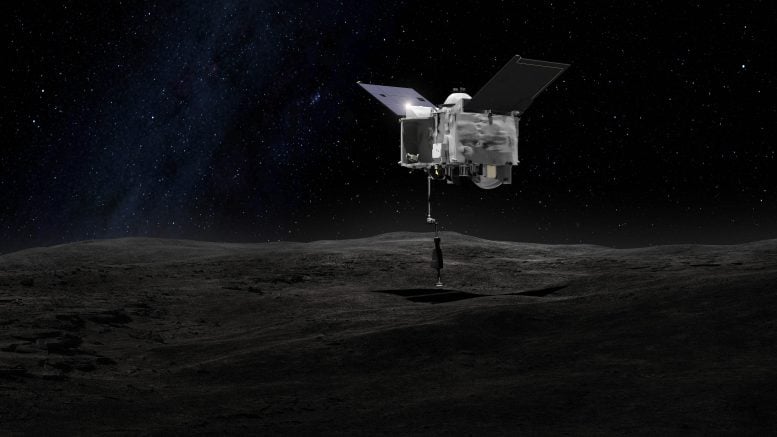
This artist’s concept shows the OSIRIS-REx (Origins Spectral Interpretation Resource Identification Security – Regolith Explorer) spacecraft contacting the asteroid Bennu with the Touch-And-Go Sample Arm Mechanism or TAGSAM. The mission successfully returned a sample of Bennu’s surface coating to Earth for study. Credit: NASA
Hints at Life’s Building Blocks
The team has also confirmed the asteroid is rich in carbon and nitrogen. These elements are crucial in understanding the environments from which Bennu’s materials originated and the chemical processes that transformed simple elements into complex molecules, potentially laying the groundwork for life on Earth.
“These findings underscore the importance of collecting and studying material from asteroids like Bennu – especially low-density material that would typically burn up upon entering Earth’s atmosphere,” said Lauretta. “This material holds the key to unraveling the intricate processes of solar system formation and the prebiotic chemistry that could have contributed to life emerging on Earth.”
What’s Next
Dozens more labs in the United States and around the world will receive portions of the Bennu sample from NASA’s Johnson Space Center in Houston in the coming months, and many more scientific papers describing the Bennu sample are expected in the next few years from the OSIRIS-REx Sample Analysis Team.
“The Bennu samples are tantalizingly beautiful extraterrestrial rocks,” said the paper’s co-lead author, Harold Connolly, the mission sample scientist who leads the Sample Analysis Team, professor at Rowan University in Glassboro, New Jersey, and a visiting research scientist at UArizona. “Each week, analysis by the OSIRIS-REx Sample Analysis Team provides new and sometimes surprising findings that are helping place important constraints on the origin and evolution of Earthlike planets.”
Reference: “Asteroid (101955) Bennu in the laboratory: Properties of the sample collected by OSIRIS-REx” by Dante S. Lauretta, Harold C. Connolly, Joseph E. Aebersold, Conel M. O’D. Alexander, Ronald-L. Ballouz, Jessica J. Barnes, Helena C. Bates, Carina A. Bennett, Laurinne Blanche, Erika H. Blumenfeld, Simon J. Clemett, George D. Cody, Daniella N. DellaGiustina, Jason P. Dworkin, Scott A. Eckley, Dionysis I. Foustoukos, Ian A. Franchi, Daniel P. Glavin, Richard C. Greenwood, Pierre Haenecour, Victoria E. Hamilton, Dolores H. Hill, Takahiro Hiroi, Kana Ishimaru, Fred Jourdan, Hannah H. Kaplan, Lindsay P. Keller, Ashley J. King, Piers Koefoed, Melissa K. Kontogiannis, Loan Le, Robert J. Macke, Timothy J. McCoy, Ralph E. Milliken, Jens Najorka, Ann N. Nguyen, Maurizio Pajola, Anjani T. Polit, Kevin Righter, Heather L. Roper, Sara S. Russell, Andrew J. Ryan, Scott A. Sandford, Paul F. Schofield, Cody D. Schultz, Laura B. Seifert, Shogo Tachibana, Kathie L. Thomas-Keprta, Michelle S. Thompson, Valerie Tu, Filippo Tusberti, Kun Wang, Thomas J. Zega, C. W. V. Wolner and , 26 June 2024, Meteoritics & Planetary Science.
DOI: 10.1111/maps.14227










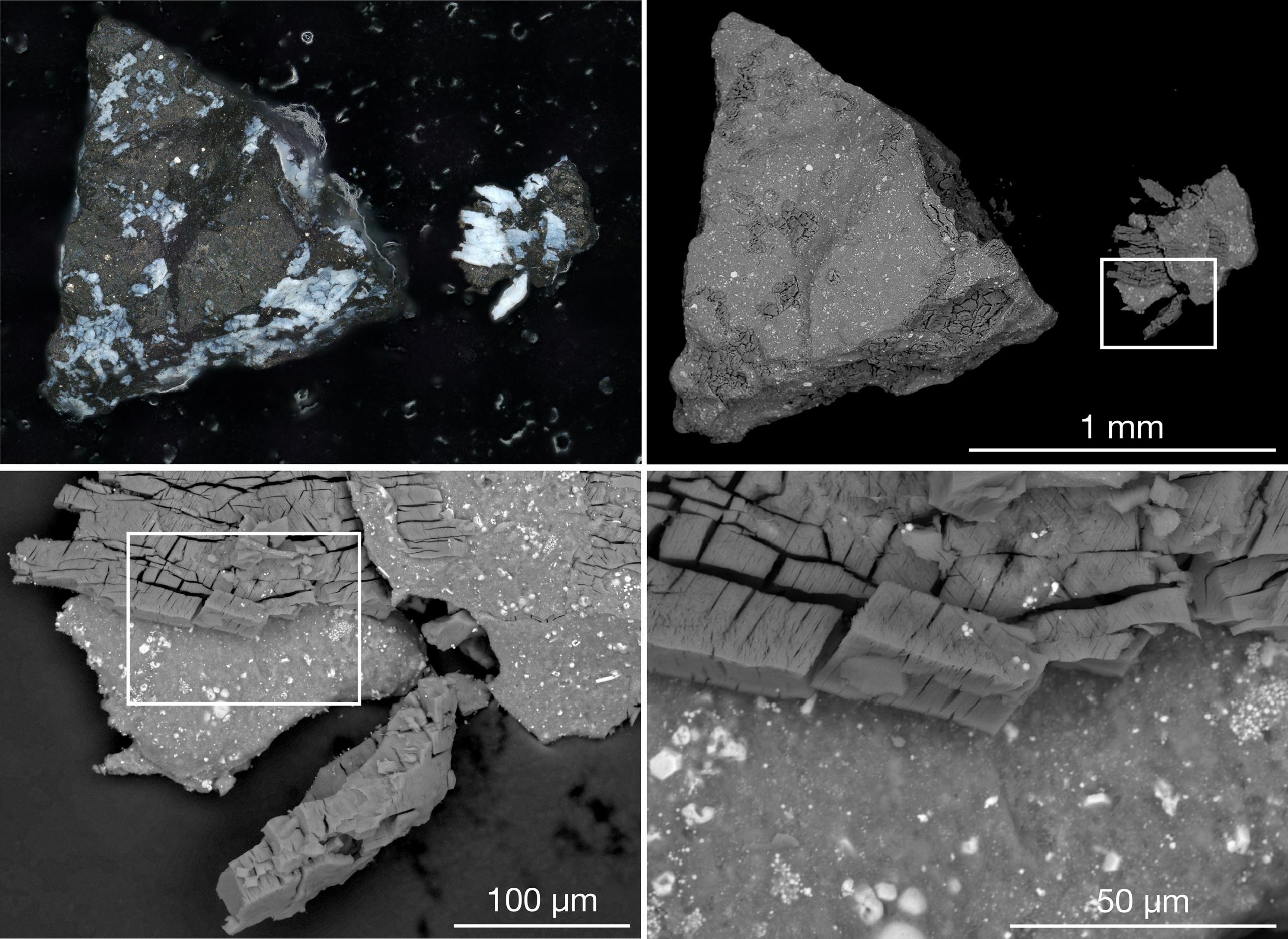
/https://tf-cmsv2-smithsonianmag-media.s3.amazonaws.com/filer_public/34/31/3431771d-41e2-4f97-aed2-c5f1df5295da/gettyimages-1441066266_web.jpg)








Discussion about this post